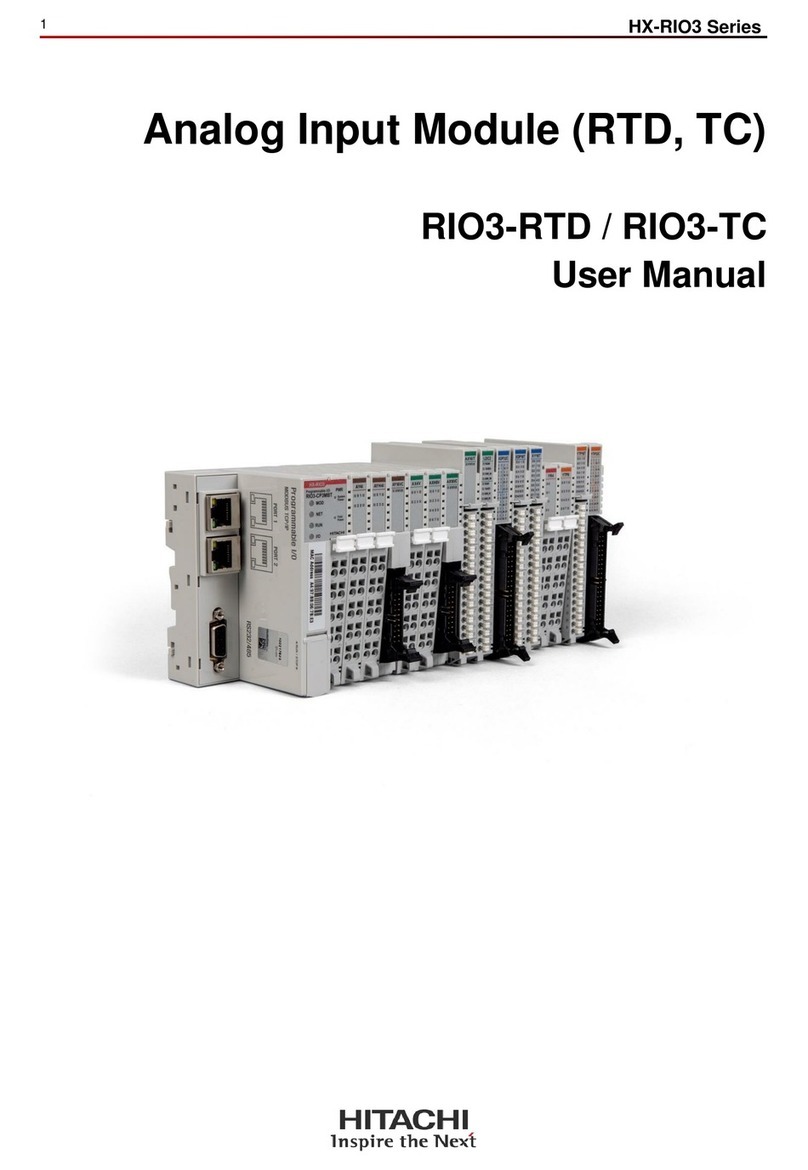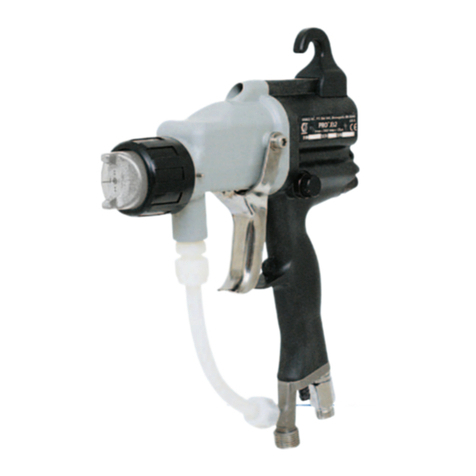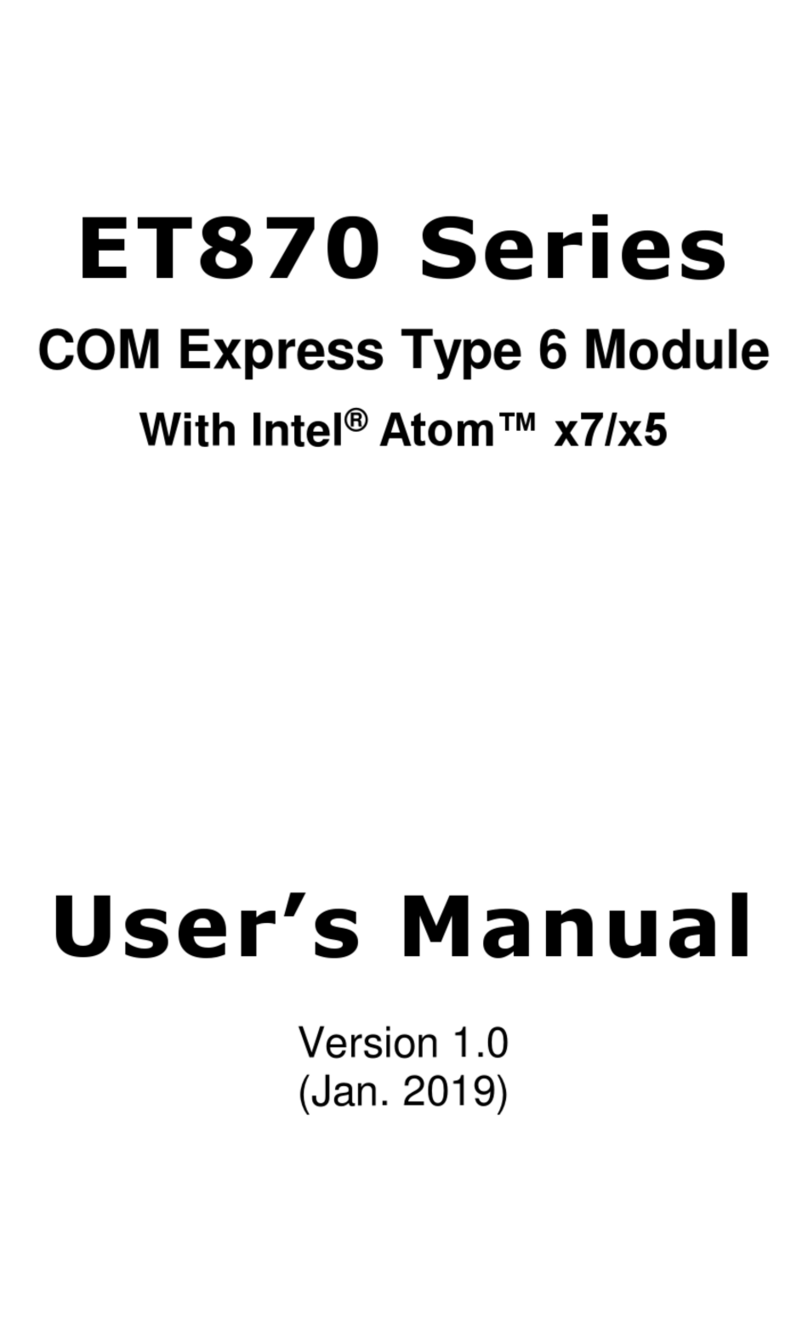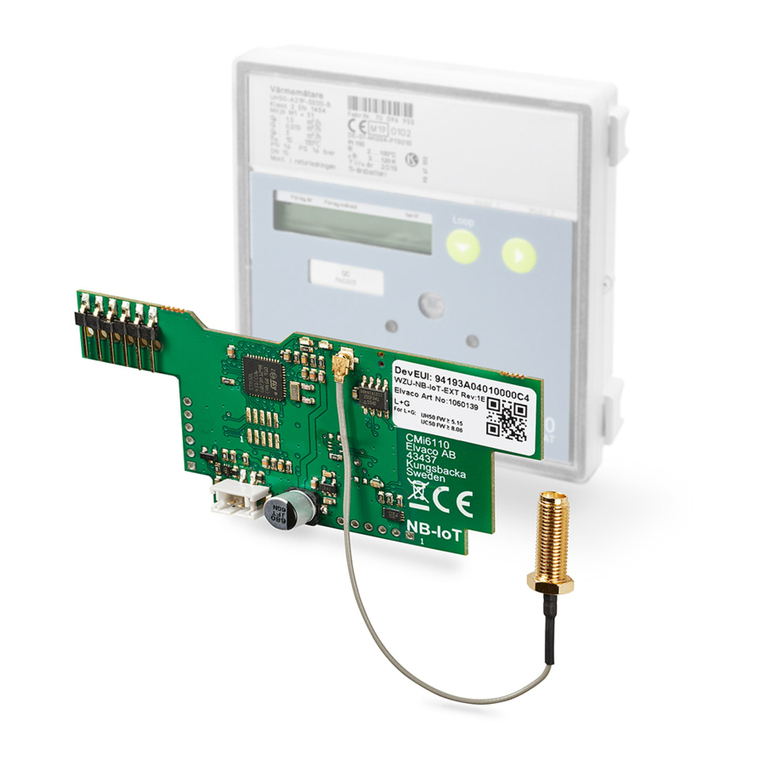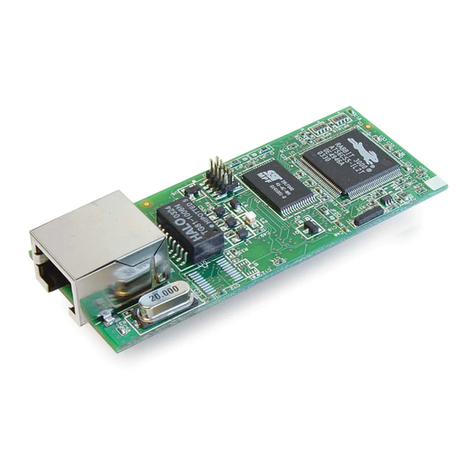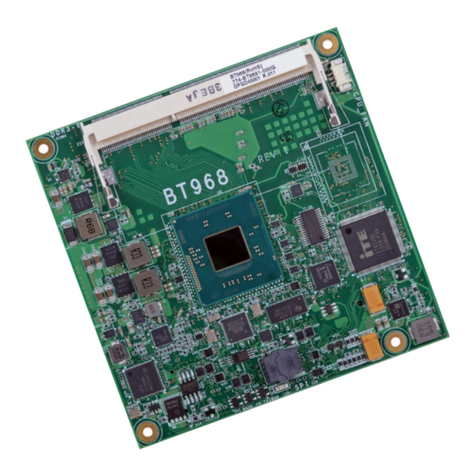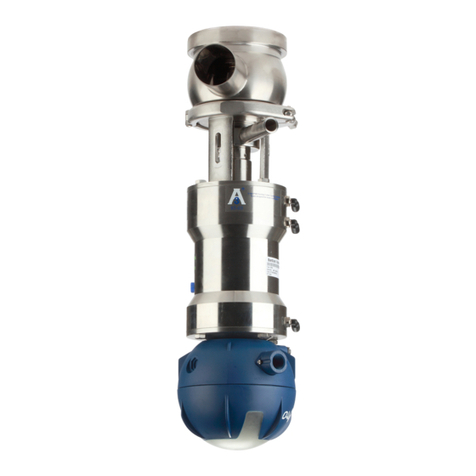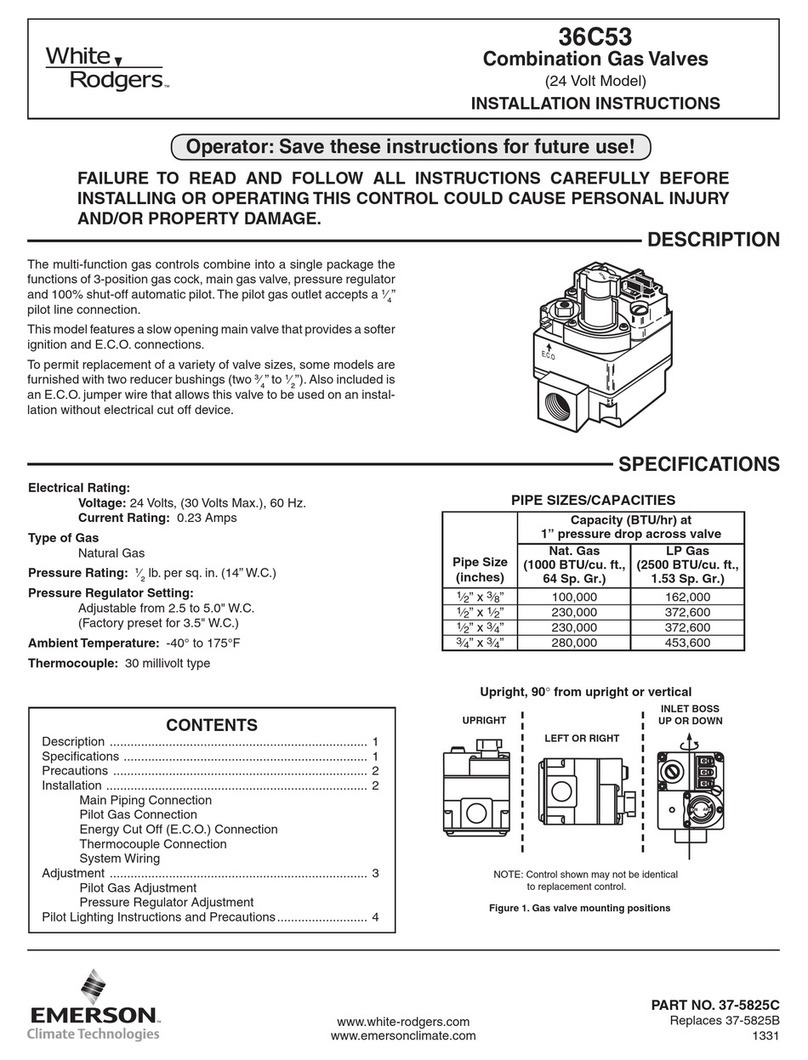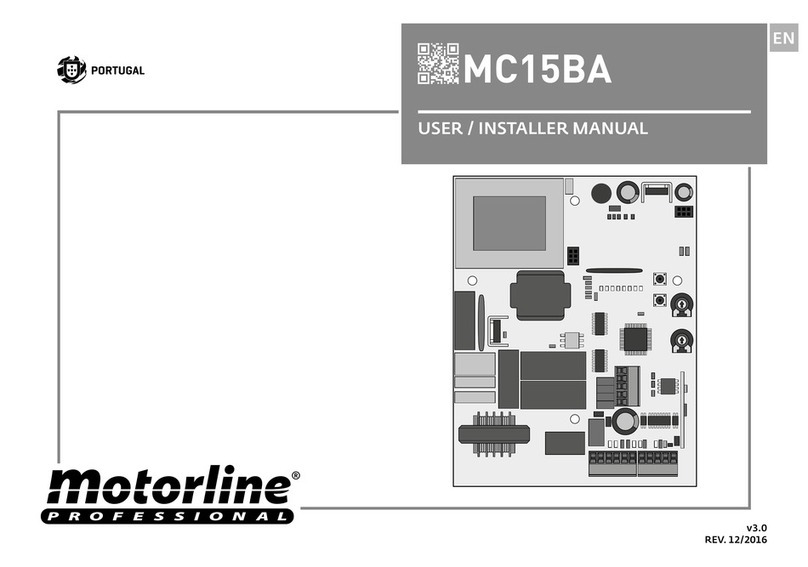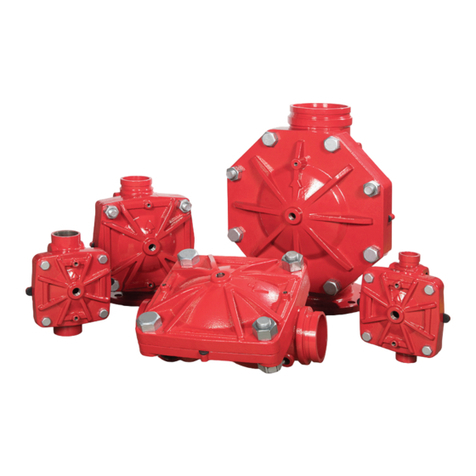EVC BDM100 User manual

Manual
BDM100

EVC electronic GmbH -2- BDM100 Module
Table of Contents
Title: Page
Important.....................................................................................................3
The BDM100 Module...................................................................................3
Interconnections for Bosch EDC16 and ME9 ECUs.................................4
Interconnections for Bosch EDC7 ECUs ..................................................5
Interconnections for Bosch ECUs using a BDM120 Cable......................6
Interconnections for Bosch ME9.0 ECUs.................................................7
Interconnections for Bosch ME9.7 ECUs.................................................8
Interconnections for Bosch MED9.7 ECUs..............................................9
Interconnections for Daimler-Chrysler ETC5 ECUs...............................10
Interconnections for Delphi ECUs...........................................................11
Interconnections for Delphi DCM3.2 ECUs.............................................12
Interconnections for Delphi DCM3.2 (MB Version) ................................13
Interconnections Marelli ECUs................................................................14
Interconnections-for Siemens HMC Theta PI ECUs...............................16
Interconnections for Siemens MS45 ECUs.............................................17
Interconnections for Siemens MSS65 ECUs ..........................................18
Interconnections for Siemens MSS70 ECUs ..........................................19
Interconnections for Siemens MSV70 ECUs ..........................................20
Interconnections for Siemens PPD1.1 ECUs..........................................21
Interconnections for Siemens SID201 ECUs ..........................................22
interconnections for Siemens SID202 ECUs and SID803A....................23
interconnections for Siemens SID203 ECUs ..........................................24
interconnections for Siemens SID204 ECUs ..........................................25
interconnections for Siemens SID206 ECUs ..........................................26
Interconnections for Siemens SID803 ECUs ..........................................27
Interconnections for Siemens SIM266 ECUs..........................................28
Interconnections for Siemens SIM2K......................................................29
Interconnections for Siemens SIM90P ECUs .........................................30
Interconnections for Siemens Simos6.x ECUs.......................................31
The Alignment of the BDM-Port Pads .....................................................32
Pin Out BDM100 Module ..........................................................................33
Pin Out BOSCH System Programming Pads..........................................33
Some ECUs with BDM capability.............................................................34
EVC electronic GmbH
Am Pfauenzehnt 11a
46539 Dinslaken
www.evc.de

EVC electronic GmbH -3- BDM100 Module
Important
Disclaimer / Warranty
The BDM module is for use by qualified personnel only. A warranty on our part for direct
damages and consequential damages, caused by the improper handling of our product or
additional products is excluded.
The interconnection between the BDM100 Module and the appropriate ECU is very easy.
Nevertheless you should read this manual carefully, because any failure may result in the destruction
of the ECU.
! To avoid damages on your BDM100-module or on an ECU, please carefully read this manual
before you start running the BDM100 Module with an ECU !
The BDM100 Module
In all cases, always connect the BDM100
module with your PC or notebook, first!.
The lower of the both blue LEDs on the
Front panel now should start flashing as
shown in picture A.
The BDM100 module has no own power
source. Its an USB-Device and obtain its
power via the USB cable.
Always make sure that all necessary
connections are done, before you apply
power to an ECU!
The upper of the both blue LEDs
indicates that an ECU connected to the
BDM100 module is supplied with the
required voltage (picture B).
Pict. A: The BDM100 Module is always connected to
the USB cable first.
Pict. B: The BDM100 module connected to an
engaged ECU.

EVC electronic GmbH -4- BDM100 Module
Interconnections for Bosch EDC16 and ME9 ECUs
When the Bosch EDC16 or ME9 ECU is
opened, you may look for a typical 14-pads
arrangement near the back border of the
printed connection board of the ECU.
It should look like as shown in Picture A.
This is the BDM-Port of the Bosch ECUs.
Note that at all only 10 pads of the total 14
pads are used for the EDC16 or ME9
programming port.
The pads with the numbers 3, 4, 13 and 14
are not used.
Ensure that the pads are clean and free of
remaining flux agent.
Now place the BDM143 probe into the
positioning frame and connect it to the
BDM100 module
Ensure that the switch of the BDM143 probe
is in its ‘OFF’-position.
Carefully put the tips of the spring contact
probes on the pads on the board as shown
in picture B.
The power supply of the BDM143 probe is
plugged into the power source connector as
shown in picture B.
Now put the switch of the BDM143 in its
‘ON’-position.
The red LED of the BDM143 and also the
upper of the two blue LEDs on the front
panel of the BDM100 module should light up
to indicate, that the ECU board is supplied
with the required voltage.
The BDM100 module is now operational.
Pict. A: These are the typical Bosch pads for BDM.
Pict. B: The BDM143 probe contacting the pads.
Pict. C: Finally the power will applied.

EVC electronic GmbH -5- BDM100 Module
Interconnections for Bosch EDC7 ECUs
On the EDC7 board the BDM port pads are
located very near the MPC555 processor.
On Picture A the orientation of the pads
arrangement is shown.
Note that at all only 10 pads of the total 14
are used for the EDC7 programming port.
The pads with the numbers 2,3,13 and 14
are not used.
Ensure that the pads are clean and free of
remaining flux agent.
On the EDC7 board the required pads are
also located in the very middle of the whole
board. Because of this you must not place
the BDM143 probe completely into the
guide slot of the positioning frame (as
shown in picture B)
Now connect the BDM143 probe to the
BDM100 module
Ensure that the switch of the BDM143 probe
is in its ‘OFF’-position.
Carefully put the tips of the spring contact
probes on the pads on the board as shown
in picture B.
It is recommended to use an isolation foil, in
order to avoid that the arm of the positioning
frame produces short-circuits between
larger components on the top side of the
board.
The power for the board will applied over
the power jack on the BDM143 adapter.
If you prefer to use the other BDM port on
the side of the ECU where the main
connectors are mounted on, a BDM141
adapter is required (Pict. C).
In that case the power to the EDC7 board is
provided by the following pins of the main
connectors (A,B):
GND BAT+ IGN
EDC7 IVECO B2 B12 B39
EDC7 MAN A15 A7 B36
Pict. A: This is the characteristic arrangement of
the Bosch BDM pads.
Pict. B: The BDM143 probe contacting the pads.
Pict. C: The other BDM-port on the top side.

EVC electronic GmbH -6- BDM100 Module
Interconnections for Bosch ECUs using a BDM120 Cable
For connecting the BDM100 module to
the EDC16 or to the ME9 ECUs the
BDM120 cable is required which is
equipped with an own power supply
First solder the 12way pin header onto
the pads for the BDM port of the EDC16
or ME9 board (picture A).
Note that at all only 10 pads of the total
14 pads are used for the EDC16 or ME9
programming port.
Now take the BDM110 cable and connect
it with the BDM120 cable as shown in
picture B.
Then connect the other side of the
BDM100 cable to the BDM100 module.
Ensure that you have plugged the 12way
connector in the 12way header exactly
as shown in picture B!
Again, ensure that all connections are
plugged in the right direction.
Finally, the power supply of the BDM120
cable is plugged into the power source
connector (picture C).
The upper of the two blue LEDs on the
front panel should light up to indicate, that
the ECU board is now supplied with the
required voltage.
The BDM100 module is now operational.
After finishing your work always remove
the power supply from the power plug
connector first before disconnecting any
other connection!
Pict. A: This is the way the pin header will soldered..
Pict. B: The direction the BDM120 must plugged!
Pict. C: Finally the power will applied.

EVC electronic GmbH -7- BDM100 Module
Interconnections Bosch ME9.0 ECUs
Pict. A: The main connector of the Bosch ME9.0 ECU.
On the Bosch ME9.0 ECU the power
distribution is provided by the pins of the
main connector.
Use separate wires with matching
connectors to connect GND and +12Vcc to
the pins of the main connector shown in
picture A.
Now place a BDM144 probe into the
positioning frame and carefully center the
tips of the spring contact probes on the
BDM-pads on the board as shown in
picture B.
The tips of the spring contact probes should
reach a spring travel of 1.5 mm minimum for
best contact conditions.
Then connect the BDM110 flat wire cable to
the BDM100 module which should already
connected to your computer.
If you then applying power to the main
connector of the ECU the red LED on the
BDM144 probe lights up to indicate that the
logic on the board is supplied with the
required voltage
The BDM100 module is now operational.
Pict. B: This are the required pads for the BDM
Interface.
Pict. C: This way the BDM144 probe contacts the
Bosch ME9.7 ECU board..

EVC electronic GmbH -8- BDM100 Module
Interconnections Bosch ME9.7 ECUs
Pict. A: The main connector of the Bosch ME9.7 ECU.
On the Bosch ME9.7 ECU the power
distribution is provided by the pins of the
main connector.
Use separate wires with matching
connectors to connect GND and +12Vcc to
the pins of the main connector shown in
picture A.
Now place a BDM141 probe into the
positioning frame and carefully center the
tips of the spring contact probes on the
BDM-pads on the board as shown in
picture B.
The tips of the spring contact probes should
reach a spring travel of 1.5 mm minimum for
best contact conditions.
Then connect the BDM110 flat wire cable to
the BDM100 module which should already
connected to your computer.
If you then applying power to the main
connector of the ECU the red LED on the
BDM141 probe lights up to indicate that the
logic on the board is supplied with the
required voltage
The BDM100 module is now operational.
Pict. B: This are the required pads for the BDM
Interface.
Pict. C: This way the BDM141 probe contacts the
board of the Bosch ME9.0 ECU..

EVC electronic GmbH -9- BDM100 Module
Interconnections Bosch MED9.7 ECUs
Pict. A: The main connector of the Bosch MED9.7 ECU.
On the Bosch ME9.7 ECU the power
distribution is provided by the pins of the
main connector.
Use separate wires with matching
connectors to connect GND and +12Vcc to
the pins of the main connector shown in
picture A.
Now place a BDM150 probe into the
positioning frame and carefully center the
tips of the spring contact probes on the
BDM-pads on the board as shown in
picture B.
The tips of the spring contact probes should
reach a spring travel of 1.5 mm minimum for
best contact conditions.
Then connect the BDM110 flat wire cable to
the BDM100 module which should already
connected to your computer.
If you then applying power to the main
connector of the ECU the red LED on the
BDM150 probe lights up to indicate that the
logic on the board is supplied with the
required voltage
The BDM100 module is now operational.
Pict. B: This are the required pads for the BDM
Interface.
Pict. C: This way the BDM150 probe contacts the
Bosch MED9.7 ECU board..

EVC electronic GmbH -10- BDM100 Module
Interconnections for Daimler-Crysler ETC5 (P02) V1.1
On the ETC5 ECU the power distribution ist
provided by the following contacts of the
"black" contact chamber (the other contact
chambers are marked with color bars).
The required contatcts for powering up the
ECU are shown in Picture A.
Use separate wires with matching
connectors to connect GND and +12Vcc to
these contact pins.
After removing the top lid of the ECU, you
can see, that the PCB is embedded in a
clear but sticky and wobbly silicone mass.
For some versions of the ETC5 ECU, a
BDM149 probe is used to contact the BDM-
pads on the board by poking the spring
contact pins through the silicone mass.
If you do not use a BDM149 probe, solder a
10-pin header onto the BDM-pads.
The position of pin1- location of the BDM-
pads is already marked in the PCB layout.
To make the P02- version of the ETC5 ECU
readable and programmable, a track on the
PCB must disrupted as shown in picture B.
For that operation, the silicone mass must
be removed.
If you then applying power to the main
connector of the ECU the red LED of the
BDM149 probe (if used) lights up to indicate
that the logic on the board is supplied with
the required voltage.
The BDM100 module is now operational.
After programming the ECU, it is recom-
mended to reconnect the disrupted PCB-
track as shown in Pictrure C.
Pict. A: The power connection on the ETC5 ECU.
Pict. B: The position ot the track that must dis-
rupted.
Pict. C The reconnected track on the ETC5 board.

EVC electronic GmbH -11- BDM100 Module
Interconnections for Delphi ECUs
Pict. A: The main connector of the Delphi ECU
In case of a Delphi ECU the power
distribution can not provided by special pads
of the BDM port.
Use separate wires to connect GND and
+12Vcc to the pins of the main connector
shown in picture A.
The voltage is provided by a stabilized
power supply or by the main connector of
the ECU at the cable harness of the car.
! Warning ! Please always remind, if the
open ECU is connected to the cable
harness of the car, it is already connected to
the battery!
Please, ensure that the ignition is
switched off while plugging the con-
nections!
Now place the BDM142 probe into the
positioning frame and carefully put the tips
of the spring contact probes on the pads on
the board as shown in picture C.
The tips of the spring contact probes should
reach a spring travel of 2mm minimum for
best contact conditions.
If you then applying power to the main
connector of the ECU the red LED of the
BDM142 probe lights up to indicate that the
logic on the board is supplied with the
required voltage.
Pict. B: The BDM pads of the Delphi ECU.
Pict. C: The BDM142 probe contacting the BDM
port pads of a Delphi ECU.

EVC electronic GmbH -12- BDM100 Module
Interconnections for Delphi DCM3.2 ECUs
Pict. A: The main connector of the Delphi DCM3.2 ECU.
On the DCM3.2 the required contacts are
located in the smaller chamber of the main
connector (Pict. A)
Use separate wires with matching
connectors to connect GND and +12Vcc to
the pins of the main connector shown in
picture A.
Compared to the standard BDM pin out, the
pin out of the BDM-pads on that board is
mirrored, probably due the board was
programmed first in the factory before
mounting it into the case (PictB).
Now place a BDM147 probe into the
positioning frame and carefully put the tips
of the spring contact probes on the pads on
the board as shown in picture C.
The tips of the spring contact probes should
reach a spring travel minimum of 2mm for
best contact conditions.
If you then applying power to the main
connector of the ECU the red LED of the
BDM147 probe lights up to indicate that the
logic on the board is supplied with the
required voltage.
The BDM100 module is now operational.
Pict. B: The location of the required Pads.
Pict. C: Like that the BDM147 probe will be
positioned over the DCM3.2 board.

EVC electronic GmbH -13- BDM100 Module
Interconnections for Delphi DCM3.x (MB Version)
Pict. A: The main connector of the Delphi DCM3.2 ECU from Daimler-Chrysler.
On the DCM3.2 the required contacts are
located in the smaller chamber of the main
connector (Pict. A)
Use separate wires with matching
connectors to connect GND and +12Vcc to
the pins of the main connector shown in
picture A
The PCB-Layout of the DCM3.2 from MB
differs slightly from the other versions.
You have to close two jumpers first before
this ECU is readable! (Pict. B)
Compared to the standard BDM pin out, the
pin out of the BDM-pads on that board is
mirrored, probably due the board was
programmed first in the factory before
mounting it into the case (PictB).
Now place a BDM147 probe into the
positioning frame and carefully put the tips
of the spring contact probes on the pads on
the board as shown in picture C.
The tips of the spring contact probes should
reach a spring travel minimum of 2mm for
best contact conditions.
If you then applying power to the main
connector of the ECU the red LED of the
BDM147 probe lights up to indicate that the
logic on the board is supplied with the
required voltage.
The BDM100 module is now operational.
Pict. B: The location of the BDM pads and the two
jumpers you have to close first.
Pict. C: Like that the BDM147 probe will be
positioned over the DCM3.2 board.

EVC electronic GmbH -14- BDM100 Module
Interconnections for Marelli ECUs
Pict. A: The main connector of the Marelli ECU
In case of a Marelli ECU the power
distribution can not provided by special pads
of the BDM port.
Use separate wires to connect GND and
+12Vcc to the pins of the main connector
shown in picture A.
The voltage is provided by a stabilized
power supply or by the main connector of
the ECU at the cable harness of the car.
! Warning ! Please always remind, if the
open ECU is connected to the cable
harness, it is already connected to the
battery!
Please, ensure that the ignition is
switched off at beginning!
Before you can start to read out or program
a Marelli ECU, you must solder out the zero-
ohm resistor witch is next pin19 of the
component with SO28 package in the cor-
ner of the ECU board (Pict. B).
There is also another Type of the Marelli
MJD- ECU which has another PCB-layout
and some other components. There the
zero-ohm resistor is placed near the flash-
EPROM (Pict. C).
Don’t forget to solder the zero-ohm resistor
on its place again when the work with the
BDM equipment is done.
Pict. B: The location of the zero-ohm resistor witch
will be out-soldered.
Pict. C: On this Marelli MJD-ECU (with another
PCB-design) the resistor is already out-soldered.

EVC electronic GmbH -15- BDM100 Module
Interconnections Marelli ECUs
The BDM110-cable is made for
connecting the BDM100 module with
ECUs using a 10way standard BDM-port
with a 0.1’ pitch.
On a Marelli board you will find a 12pad
array with 0,05’ pitch for the BDM port.
Two of them, pad 11 and pad 12 are
unused (pitcure D).
Now place the BDM144 probe into the
positioning frame and carefully put the tips
of the spring contact probes on the pads
on the board as shown in picture E.
If the length of the spring contact pins
should be to short, pull the spring contact
pins up to the first rest position from the
receptacles.
The tips of the spring contact probes
should reach a spring travel of 2mm
minimum for best contact conditions.
If you then applying power to the main
connector of the ECU the red LED of the
BDM144 probe lights up to indicate that
the logic on the board is supplied with the
required voltage.
Pict. D: The BDM pads of the Marelli ECU.
Pict. E: The BDM144 probe contacting the BDM port
pads of a Marelli ECU.

EVC electronic GmbH -16- BDM100 Module
Interconnections Siemens HMC Theta PI ECUs
Pict. A: The main connector of the Siemens HMC Theta PI-ECU.
On the Siemens MS45 ECU the power
distribution is provided by the pins of the
main connector as shown in picture A.
Use separate wires to connect GND and
+12Vcc to the pins of the main connector
shown in picture A.
Now place the BDM144 probe into the
positioning frame and carefully put the tips
of the spring contact probes on the pads on
the board as shown in picture C.
If the length of the spring contact pins
should be to short, pull the spring contact
pins up to the first rest position from the
receptacles.
The tips of the spring contact probes should
reach a spring travel of 1mm minimum for
best contact conditions.
If you then applying power to the main
connector of the ECU the red LED of the
BDM144 probe lights up to indicate that the
logic on the board is supplied with the
required voltage
The BDM100 module is now operational
Pict. B: Only ten of the present 12 pads will be
used. The extra both are not connected.
Pict. C: The tips of the spring contact probes
should reach a spring travel of 2mm minimum for
best contact conditions

EVC electronic GmbH -17- BDM100 Module
Interconnections for Siemens MS45 ECUs
+12Vcc (1-7)
GND (1-4)
+12Vcc (4-26)
Pict.A: The main connector of the MS45 ECU.
In case of the Siemens MS45 ECU the
power distribution is provided by the pins of
the main connector marked in picture 19.
Use separate wires to connect GND and
+12Vcc to the pins of the main connector
shown in picture A.
The voltage is provided by a stabilized
power supply or by the main connector of
the ECU at the cable harness of the car.
! Warning ! Please always remind, if the
open ECU is connected to the cable
harness of the car, it is already connected to
the battery!
Please, ensure that the ignition is
switched off at beginning!
Now place the BDM141 probe into the
positioning frame and carefully put the tips
of the spring contact probes on the pads on
the board as shown in picture C.
If the length of the spring contact pins
should be to short, pull the spring contact
pins up to the first rest position from the
receptacles.
The tips of the spring contact probes should
reach a spring travel of 1mm minimum for
best contact conditions.
If you then applying power to the main
connector of the ECU the red LED of the
BDM141 probe lights up to indicate that the
logic on the board is supplied with the
required voltage
The BDM100 module is now operational.
Pict. B: On the MS45 board the BDM-Pads are
arranged very centrically.
Pict. C: The BDM141 contacting BDM- Pads.

EVC electronic GmbH -18- BDM100 Module
Interconnections for Siemens MSS65 ECUs
Pict.A: The main connector of the MSS65 ECU.
On the Siemens MS45 ECU the power
distribution is provided by the pins of the
main connector as shown in picture 19a.
Use separate wires to connect GND and
+12Vcc to the pins of the main connector
shown in picture A.
On the MSS65 board there are two
processors which each own programming
port pad arrays. Each array consist of 30
pads but only the first 10 of them are used
for BDM purposes.
For connecting the BDM-pads controllable
the BDM141 and also the BDM144 probe
are required.
Now place the BDM probes in succession
into the positioning frame and carefully put
the tips of the spring contact probes on the
pads on the board as shown in picture B
and picture C.
If the length of the spring contact pins
should be to short, pull the spring contact
pins up to the first rest position from the
receptacles.
The tips of the spring contact probes should
reach a spring travel of 1mm minimum for
best contact conditions.
If you then applying power to the main
connector of the ECU the red LED of the
BDM14x probe lights up to indicate that the
logic on the board is supplied with the
required voltage
The BDM100 module is now operational
Pict. B: On the MSS65 board both the BDM144
(shown in this picture) and the BDM141 probes are
required.
Pict.C: The BDM141 probe contacting the BDM-
pads of the second processor..

EVC electronic GmbH -19- BDM100 Module
Interconnections for Siemens MSS70 ECUs
Pict. A: The main connector of the Siemens MSS70 ECU like on the MSV70 ECU.
The programming of the MSS70 ECU is
very similarly to the programming of the
MSV70 ECU.
On the Siemens MSS70 ECU the power
distribution is provided by the pins of the
main connector as shown in picture A.
Use separate wires to connect GND and
+12Vcc to the pins of the main connector
shown in picture A
Don't forget to close the jumper pads shown
on picture B!
Now place the BDM141 probe into the
positioning frame and carefully center the
tips of the spring contact probes on the
BDM-pads on the board as shown in
picture B.
Then connect the BDM110 flat wire cable to
the BDM100 module which must already
connected to your computer.
The tips of the spring contact probes should
reach a spring travel of 1mm minimum for
best contact conditions.
If you then applying power to the main
connector of the ECU the red LED of the
BDM141 probe lights up to indicate that the
logic on the board is supplied with the
required voltage
The BDM100 module is now operational.
Pict. B: This are the pads which are required fo the
BDM interface.
Pict.C: Make sure, that you are not producing
short circuits, if you are lowering the arm of the
positioning frame!

EVC electronic GmbH -20- BDM100 Module
Interconnections for Siemens MSV70 ECUs
Pict. A: The main connector of the Siemens MSV70 ECU (equal to the one of the MSS65 ECU).
On the Siemens MSV70 ECU the power
distribution is provided by the pins of the
main connector as shown in picture 31.
Use separate wires to connect GND and
+12Vcc to the pins of the main connector
shown in picture A
To make the BDM100-Modul able to
recognize the ECU, a drop of solder or a
zero-Ohm resistor is required. Place it
between the both solder pads which are
marked by a yellow circle on picture B.
Now place the BDM141 probe into the
positioning frame and carefully center the
tips of the spring contact probes on the
BDM-pads on the board as shown in
picture C.
Then connect the BDM110 flat wire cable to
the BDM100 module which must already
connected to your computer.
The tips of the spring contact probes should
reach a spring travel of 1mm minimum for
best contact conditions.
If you then applying power to the main
connector of the ECU the red LED of the
BDM141 probe lights up to indicate that the
logic on the board is supplied with the
required voltage
The BDM100 module is now operational.
Pict. B: This are the pads which are required fo the
BDM interface. The required jumper is marked by a
yellow circle.
Pict.C: Make sure, that you are not producing
short circuits, if you are lowering the arm of the
positioning frame!
Table of contents
